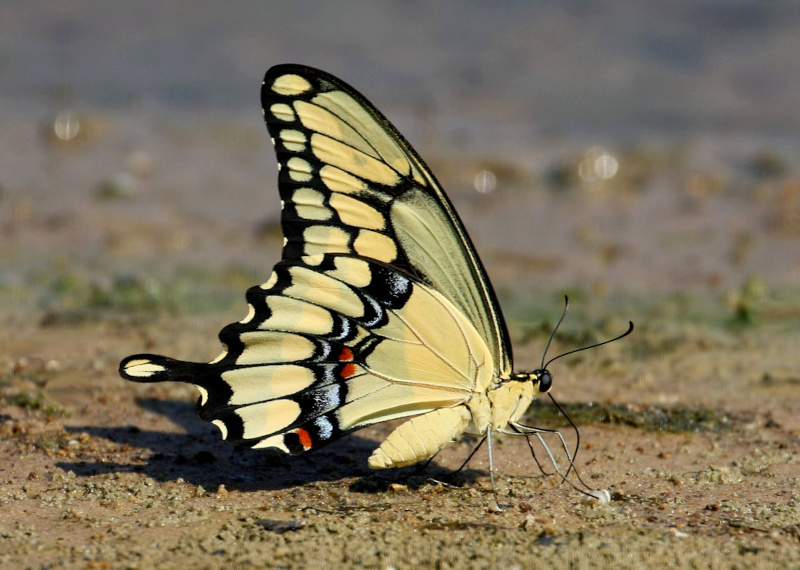
Giant Swallowtail Facts
- This magnificent work of Nature most frequently goes by the appropriate common name of the Giant Swallowtail for good reasons. For the moment, at least, this marvel of evolutionary processes holds no other broadly accepted general title. That’s not very common.
- Inside of scientific circles, however, the creature does have another moniker by which it’s perhaps much better known. Thankfully for the layperson, that’s a comparatively simple one to pronounce. That’s because it bears the technical designation of Papilio cresphontes.
- The beautiful Lepidoptera received that specific epithet due to the efforts of Pieter Cramer. The respected Dutch entomologist accomplished the first recognition of it as a separate and distinct species. He managed that scientifically noteworthy deed in the year 1777.
- The species currently remains most noted for several factors. This stunning invertebrate ranks as the largest of all known species of butterfly found in its part of the world. Sadly, though, its caterpillar form is now considered an extreme pest by those in the citrus industry.
- Fortunately, the amazing Giant Swallowtail appears to presently be maintaining a fully healthy population base. That pleasant state additionally seems to hold true across its entire range. The IUCN therefore presently lists the insect as Least Concern on its published Red List.
- The stunning Arthropod nevertheless faces the same potential threats to its continued existence as a species that all other forms of life on earth now do. Most of these dangers stem from the actions of man. These perils include the dangers of habitat loss and climate change.
Related Articles
Giant Swallowtail Physical Description
The breathtaking Giant Swallowtail certainly captures the attention and appreciation of most individuals fortunate enough to encounter it. Given its very name, its sheer size alone easily serves as one clear reason. Yet, the beauty and majesty of its appearance also distinguishes the insect.
The lovely creature also shares certain of the natural aspects typical of its many kindred. Among those is the fact that it displays a certain degree of the physiological characteristic of sexual dimorphism. In this instance, the natural trait manifests itself in terms of both its size and coloring.
Females of the species attain a greater average wingspan than that of their males counterparts. The actual difference remains relatively minor, though. The wings of the females measure a mean span equaling 5.8 in (15 cm). Those of males, meanwhile, only average approximately 5.5 in (14 cm).
Obviously, exceptional specimens of the wonder of the insect world do occur occasionally. These examples, when they do appear, develop greater dimension wholly regardless of gender. Yet, even the largest of these rarely exceed the typical measurements by any significant amount.
The other way in which the different sexes of the enthralling Giant Swallowtail differ mainly lies in their coloring. On the upperside, all its wings display primary background of black. A line of yellow markings crosses the upper wings, along with a row of yellow dots along the back edges.
The underside of the delicate, gorgeous wings, however, display a much different pattern of coloring. That portion of the Arthropod principally presents a background composed of various shades of yellow. Accents do appear in several places on these, but those consist of shades of black.
All of this contrasts with a few other highly notable physical features. Also situated on the back, inner corner of the upper side of the wings, two very small red spots lie within a tiny blue circle. Females also set separate themselves from the males by having slightly more rounded wings.
- Kingdom: Animalia
- Phylum: Arthropoda
- Class: Insecta
- Order: Lepidoptera
- Family: Papilionidae
- Genus: Papilio
- Species: P. cresphontes
Giant Swallowtail Distribution, Habitat, and Ecology
The appropriately-named Giant Swallowtail apparently evolved as endemic to a relatively large swathe of the surface of the earth. The location of that zone of habitation probably won’t surprise our readers, however. That’s because this marvel developed as native to North America.
Within that greater overall range, though, the species primarily makes its home inside the borders of the United States. There, the fabulous invertebrate lives in virtually all regions of the country. Its range also extends into southern Canada, northern Mexico, and even Cuba and Jamaica.
This remarkable Lepidoptera displays an impressive versatility regarding its choice of habitat. Provided the specific region inside its greater range possesses a temperate climate, it appears in an extremely braod range of local ecosystems. That’s a truly great evolutionary advantage.
The beautiful butterfly does mainly choose to live in regions of either deciduous forests of orange orchards. Yet, due to its adaptability, the fascinating insect also occurs in such areas as open woodlands, fields, bogs, and marshes. Amazingly, it even frequents cities, towns, and suburbs.
The voracious larvae of the intriguing Giant Swallowtail further show a truly strong preference for citrus fruits. They do, however, also now feed on several introduced species. The adults, though, mainly consume the nectar of a variety of plants, including honeysuckle, azaleas, and lantana.
Subsequent to mating, the females generally lay their eggs on the top of the leaves of a suitable host plant. Once hatched, the larvae go through five stages of development. Among both larvae and adults, its main predators consist of most avian species found in its natural environment.
Species Sharing Its Range
Check out our other articles on 4 Supremely Stunning Squirrels, Eurasian Brown Bear, Corsica, Fire Salamander, Coral Honeysuckle, Spiny Butterfly Ray, Evening Cicada, Jamaican Iguana
